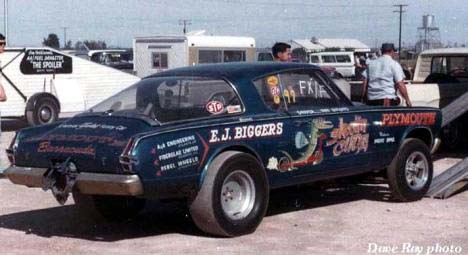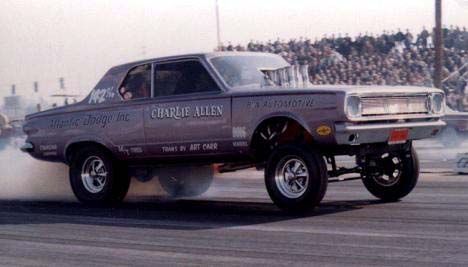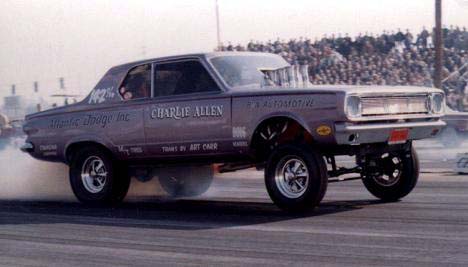By Danny White

One of famed funny car racer Gary Bolger’s early rides was the Tension II, owned by Bud Richter, Fred J. Smith, and Bolger himself. The Chevy II was powered by a bored and stroked 327 Chevy that measured 382 cubic inches. A big block replaced the small block by 1967 to keep up with the competition. The Tension II was a regular at the area’s local match race tracks like US 30, Union Grove, and others. Bolger ran a 9.39, 138 at Cordova in 1966 with the small block and an 8.99, 150 known best with the big block in 1967. The match bash Chevy II was replaced by a modern Camaro in 1967. (Photo by Robert Snayko; info from Draglist files)
Jimmy Adcock and his father Andy jumped into the match bash wars with this brand new Chevelle in 1965. The Texas-based team raced the Tiger II out of their A&B Machine Shop in Amarillo. The car was highly modified to fit a big block injected nitro Chevy in the frame rails. Adcock ran mid-tens in the wild wheelstanding Chevy raced in 1965 and 1966. The car has recently been found and identified as the Tiger II Chevelle. It is unknown whether it will be restored as the 1965 Tiger II. (Unknown Photo; info from Draglist files)
Emmet “Rattlesnake” Austin was a legendary match racer from Phenix City, Alabama. Austin was a Ford man for sure in his infamous Ford Thunderbolt. Austin began racing the car as an A/FX and kept on updating the car as the years went by. By 1965 Austin was one of the first funny car racers in the South with the black T-Bolt. The Thunderbolt had its battle scars, and Austin was proud of them. According to Grady Bryant, Rattlesnake even used the car’s scratches and dents to intimidate the other driver before a match race. Austin ran mid-tens in the Thunderbolt and even ran at a NASCAR national event before fading into drag racing obscurity. (Photo by L&M Photos; info from Draglist files)
Pete Arend was better known for racing his Corvette in the AA/MSP class in the NHRA, but the lure of match racing for money called. The highly altered Corvette featured a setback engine that left Arend very little legroom in the already tight confines of the Corvette. The Mongoose had the perfect look of the match basher: a jacked-up stance and mile-high injector stacks. The Corvette was not raced as a match basher for long because it quickly became outdated. A new Corvair raced by Buck Campbell replaced the Corvette. (Photo by Roger Swanson, courtesy of www.georgiadragracing.com; info from Draglist files)
The Entertainer match basher was a typical funny car of the day in 1966. The Wagner & Prouty-owned Chevelle was like many other match bashers in that it was heavily modified from a stock machine. The Illinois-based race car was driven by Gerald Brennan on the UDRA circuit in 1966 and raced as far south as Georgia. Like many early first-year funny cars, the Entertainer match basher was outdated by the end of 1966. (Photo by Rick Jordan, courtesy of www.georgiadragracing.com; info from Draglist files)
Sam Balkin was one of the first match bashers out of Minnesota. Balkin chose the powerful 427 SOHC Ford to power his Falcon. The little Ford was built from a factory steel body and was altered to fit Balkin’s needs. Sam ran a best of 9.05 at 156 in 1966. (Photo by Vern Scholz; info from Draglist files)
Texas match race legend Grady Bryant began his match racing days in the early sixties in a 409-powered Chevy along with Dickie Harrell. By 1966, Harrell had moved to Texas and teamed with famed Super Stock racer Roger Caster on the Sump ‘N’ Else Chevy II. This is the first Sump ‘N’ Else built by Bryant & Caster. The car was a fiberglass 1966 Chevy II built on a tube chassis but built within the parameters of a match basher. The Chevy II was not raced for long before a crash destroyed the car in Tulsa. The car had run in the nines before the crash. Caster and Bryant built a newer version of the Sump ‘N’ Else that was highly successful in match racing in the Texas area. (Photo by Dave Ray; info from Draglist files)
Dale Armstrong became a well-known drag racer in the Canuck Chevy II. The car started life as a stock machine but went through many changes. Armstrong continued to update the little blue Chevy, eventually gutting the car, as shown in the photo. Dale cut the top off the car and finally turned it into a flip-top funny car. Armstrong experimented with engine set-ups in the Canuck, including the use of nitrous. Armstrong ran as quickly as 8.89 with a small block. (Photo by L&M Photos; info from Draglist files)
Biggers & Loo were early match racers from the Kansas City area. The team ran funny cars since the inception of the category with a 65 Plymouth, which they replaced in mid-66 with this blue Barracuda called the Skootin’ Cuda. The ex-Sites Brothers machine was driven by Don Biggers, as shown here. Doc Spence and Ray Sullins had driven for the Sites Brothers. The car was replaced by a modern flip-top Cuda in 1968. (Photo by Dave Ray; info from Draglist files)
Charlie Allen’s boyish looks and professional approach to drag racing earned him the nickname of All American Boy in the 1960s. Charlie began to build a reputation in the Super Stock ranks and joined the funny car movement as it happened. The 65 Dodge Dart was a very highly modified stocker that Allen updated each year until it was a full-blown funny car. The Dart was a consistent winner on the west coast in the early funny car wars, running an 8.40 best with injectors and an 8.03 with a blower. (Photo by L&M Photos; info from Dennis Doubleday and Draglist files)
